University Assignment: Applied Corporate Strategy of Tesla Report
VerifiedAdded on 2022/08/14
|22
|4268
|13
Report
AI Summary
This report provides a comprehensive strategic analysis of Tesla, focusing on its corporate strategy within the automotive industry circa 2016. The analysis begins with an external assessment, utilizing PESTLE and Porter's Five Forces frameworks to identify opportunities, threats, and industry attractiveness. It then delves into an internal analysis, evaluating Tesla's resources, capabilities, and core competencies, including a VRIO analysis and value chain assessment. The report also examines a specific strategic decision, the acquisition of SolarCity, evaluating its success using the SAF criteria. The report highlights Tesla's strengths in technology and innovation, while also acknowledging financial weaknesses. The report provides a thorough overview of Tesla's strategic position and decision-making processes within a dynamic and evolving industry.
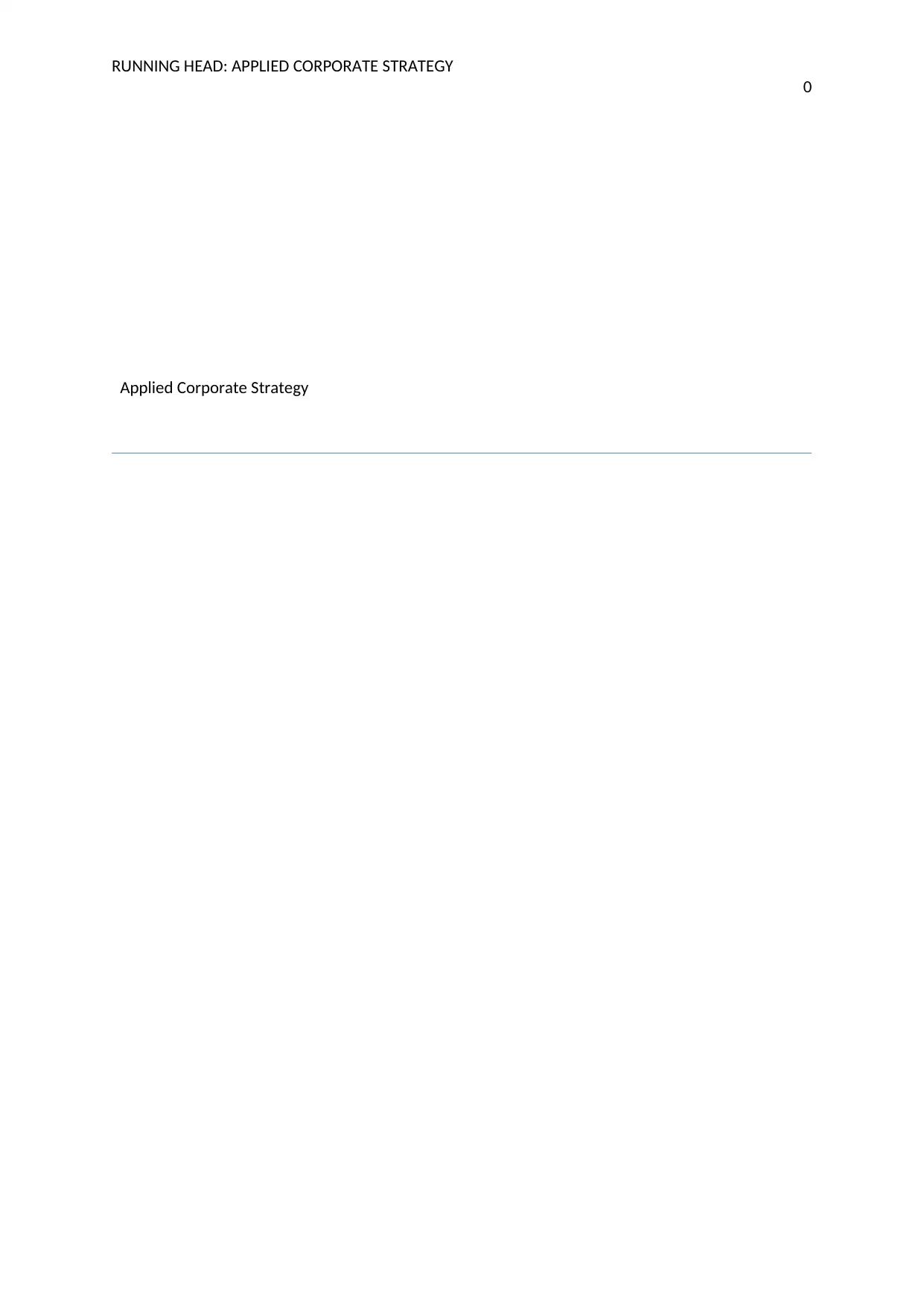
RUNNING HEAD: APPLIED CORPORATE STRATEGY
0
Applied Corporate Strategy
0
Applied Corporate Strategy
Paraphrase This Document
Need a fresh take? Get an instant paraphrase of this document with our AI Paraphraser
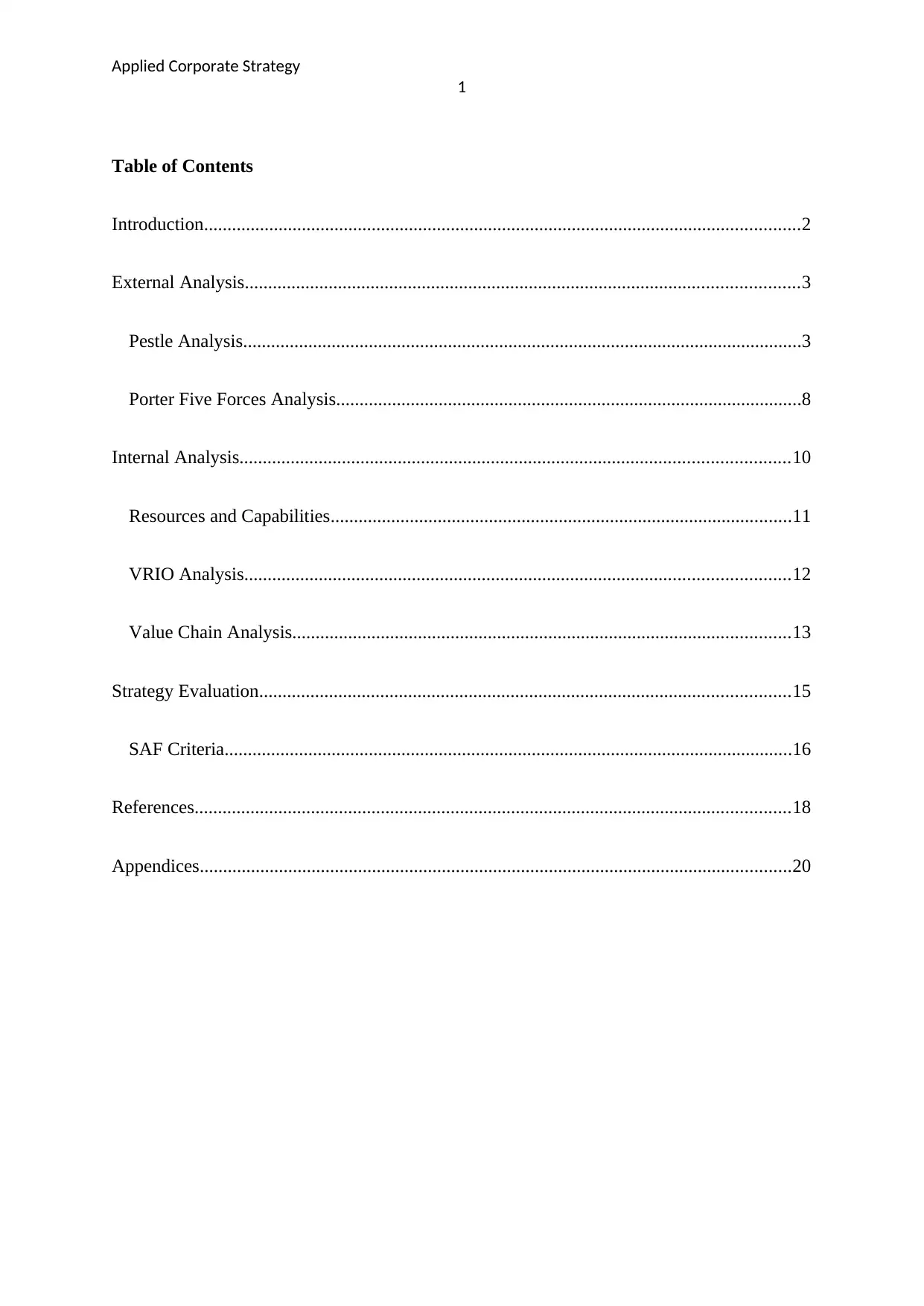
Applied Corporate Strategy
1
Table of Contents
Introduction................................................................................................................................2
External Analysis.......................................................................................................................3
Pestle Analysis........................................................................................................................3
Porter Five Forces Analysis....................................................................................................8
Internal Analysis......................................................................................................................10
Resources and Capabilities...................................................................................................11
VRIO Analysis.....................................................................................................................12
Value Chain Analysis...........................................................................................................13
Strategy Evaluation..................................................................................................................15
SAF Criteria..........................................................................................................................16
References................................................................................................................................18
Appendices...............................................................................................................................20
1
Table of Contents
Introduction................................................................................................................................2
External Analysis.......................................................................................................................3
Pestle Analysis........................................................................................................................3
Porter Five Forces Analysis....................................................................................................8
Internal Analysis......................................................................................................................10
Resources and Capabilities...................................................................................................11
VRIO Analysis.....................................................................................................................12
Value Chain Analysis...........................................................................................................13
Strategy Evaluation..................................................................................................................15
SAF Criteria..........................................................................................................................16
References................................................................................................................................18
Appendices...............................................................................................................................20
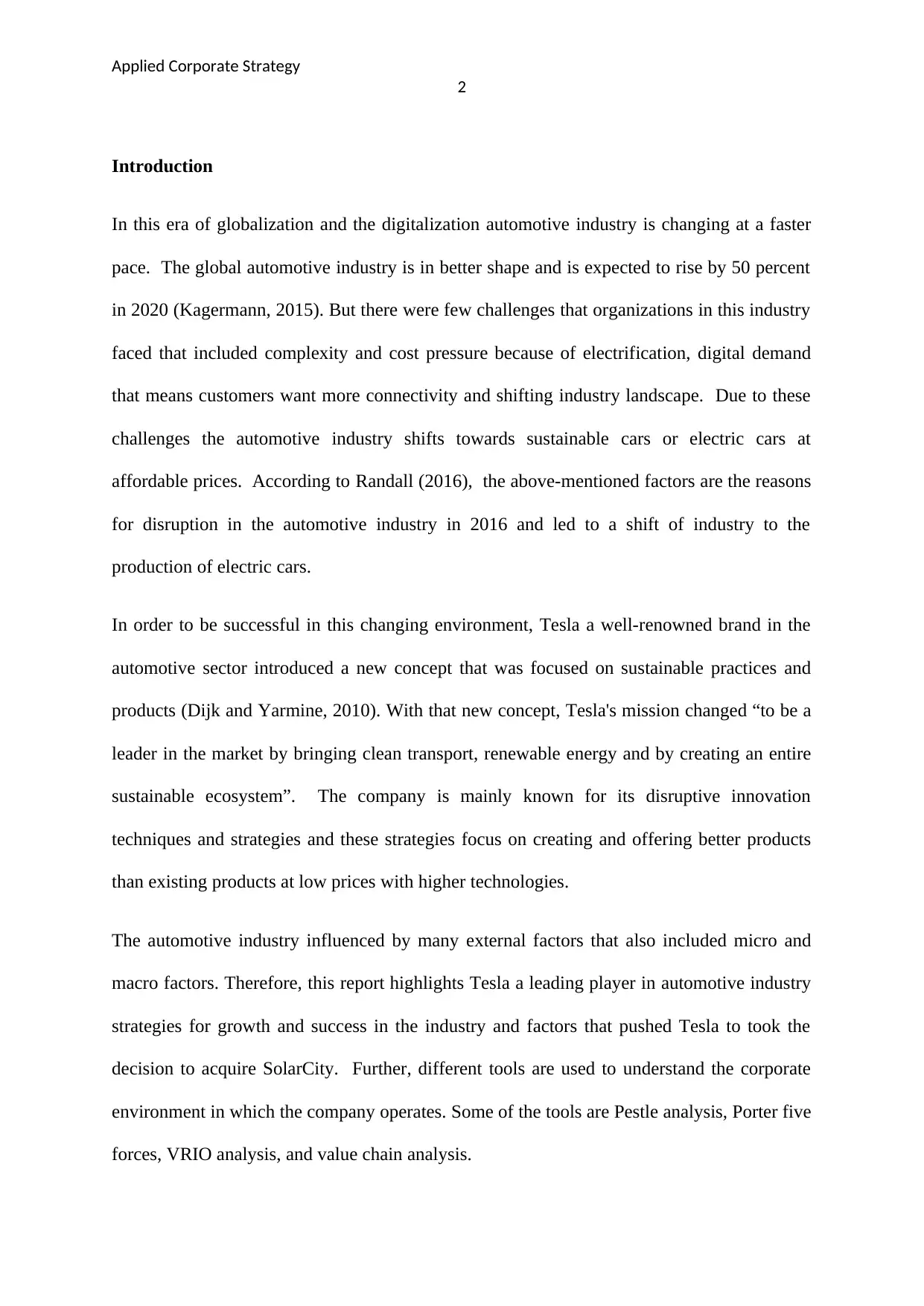
Applied Corporate Strategy
2
Introduction
In this era of globalization and the digitalization automotive industry is changing at a faster
pace. The global automotive industry is in better shape and is expected to rise by 50 percent
in 2020 (Kagermann, 2015). But there were few challenges that organizations in this industry
faced that included complexity and cost pressure because of electrification, digital demand
that means customers want more connectivity and shifting industry landscape. Due to these
challenges the automotive industry shifts towards sustainable cars or electric cars at
affordable prices. According to Randall (2016), the above-mentioned factors are the reasons
for disruption in the automotive industry in 2016 and led to a shift of industry to the
production of electric cars.
In order to be successful in this changing environment, Tesla a well-renowned brand in the
automotive sector introduced a new concept that was focused on sustainable practices and
products (Dijk and Yarmine, 2010). With that new concept, Tesla's mission changed “to be a
leader in the market by bringing clean transport, renewable energy and by creating an entire
sustainable ecosystem”. The company is mainly known for its disruptive innovation
techniques and strategies and these strategies focus on creating and offering better products
than existing products at low prices with higher technologies.
The automotive industry influenced by many external factors that also included micro and
macro factors. Therefore, this report highlights Tesla a leading player in automotive industry
strategies for growth and success in the industry and factors that pushed Tesla to took the
decision to acquire SolarCity. Further, different tools are used to understand the corporate
environment in which the company operates. Some of the tools are Pestle analysis, Porter five
forces, VRIO analysis, and value chain analysis.
2
Introduction
In this era of globalization and the digitalization automotive industry is changing at a faster
pace. The global automotive industry is in better shape and is expected to rise by 50 percent
in 2020 (Kagermann, 2015). But there were few challenges that organizations in this industry
faced that included complexity and cost pressure because of electrification, digital demand
that means customers want more connectivity and shifting industry landscape. Due to these
challenges the automotive industry shifts towards sustainable cars or electric cars at
affordable prices. According to Randall (2016), the above-mentioned factors are the reasons
for disruption in the automotive industry in 2016 and led to a shift of industry to the
production of electric cars.
In order to be successful in this changing environment, Tesla a well-renowned brand in the
automotive sector introduced a new concept that was focused on sustainable practices and
products (Dijk and Yarmine, 2010). With that new concept, Tesla's mission changed “to be a
leader in the market by bringing clean transport, renewable energy and by creating an entire
sustainable ecosystem”. The company is mainly known for its disruptive innovation
techniques and strategies and these strategies focus on creating and offering better products
than existing products at low prices with higher technologies.
The automotive industry influenced by many external factors that also included micro and
macro factors. Therefore, this report highlights Tesla a leading player in automotive industry
strategies for growth and success in the industry and factors that pushed Tesla to took the
decision to acquire SolarCity. Further, different tools are used to understand the corporate
environment in which the company operates. Some of the tools are Pestle analysis, Porter five
forces, VRIO analysis, and value chain analysis.
⊘ This is a preview!⊘
Do you want full access?
Subscribe today to unlock all pages.

Trusted by 1+ million students worldwide
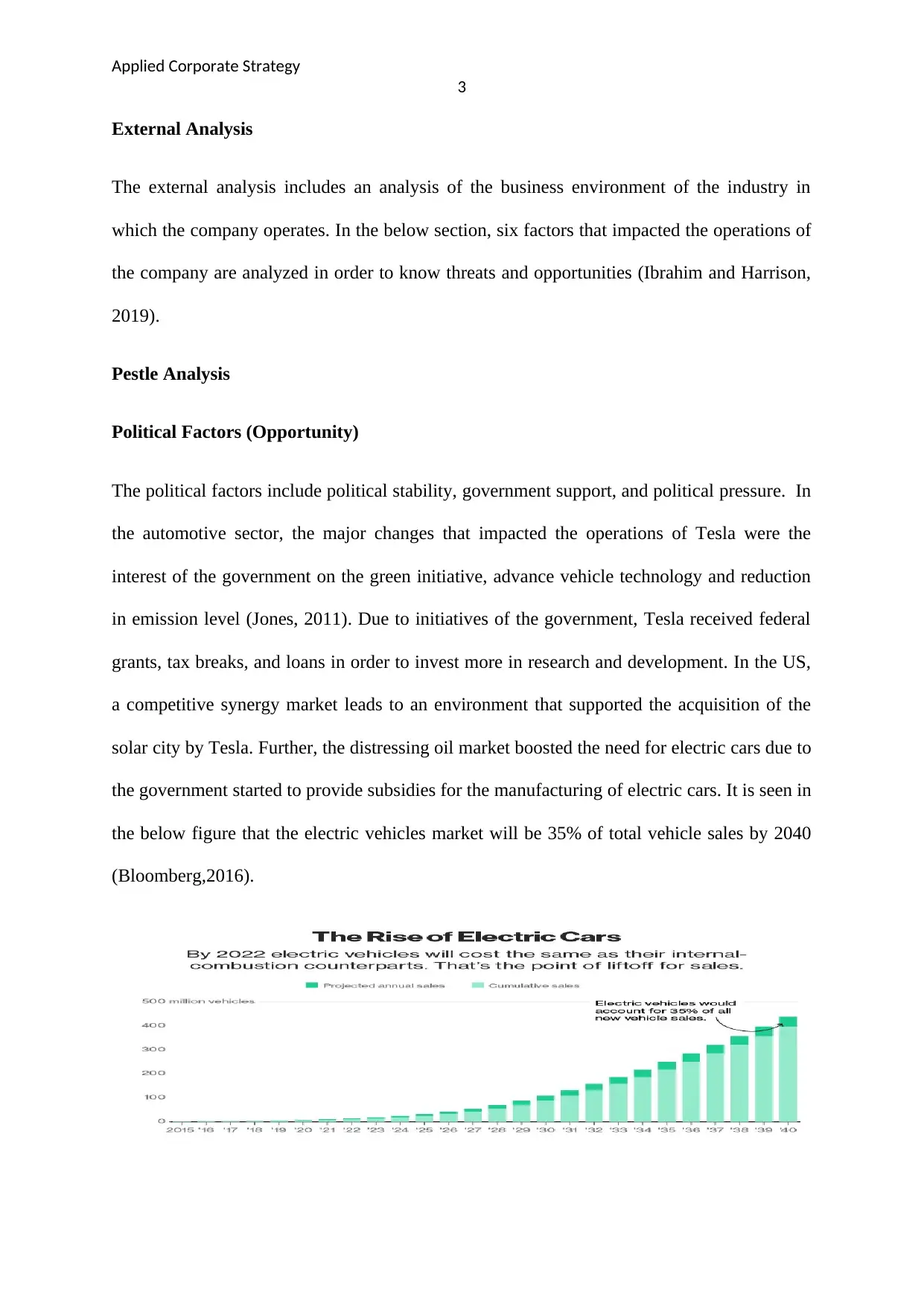
Applied Corporate Strategy
3
External Analysis
The external analysis includes an analysis of the business environment of the industry in
which the company operates. In the below section, six factors that impacted the operations of
the company are analyzed in order to know threats and opportunities (Ibrahim and Harrison,
2019).
Pestle Analysis
Political Factors (Opportunity)
The political factors include political stability, government support, and political pressure. In
the automotive sector, the major changes that impacted the operations of Tesla were the
interest of the government on the green initiative, advance vehicle technology and reduction
in emission level (Jones, 2011). Due to initiatives of the government, Tesla received federal
grants, tax breaks, and loans in order to invest more in research and development. In the US,
a competitive synergy market leads to an environment that supported the acquisition of the
solar city by Tesla. Further, the distressing oil market boosted the need for electric cars due to
the government started to provide subsidies for the manufacturing of electric cars. It is seen in
the below figure that the electric vehicles market will be 35% of total vehicle sales by 2040
(Bloomberg,2016).
3
External Analysis
The external analysis includes an analysis of the business environment of the industry in
which the company operates. In the below section, six factors that impacted the operations of
the company are analyzed in order to know threats and opportunities (Ibrahim and Harrison,
2019).
Pestle Analysis
Political Factors (Opportunity)
The political factors include political stability, government support, and political pressure. In
the automotive sector, the major changes that impacted the operations of Tesla were the
interest of the government on the green initiative, advance vehicle technology and reduction
in emission level (Jones, 2011). Due to initiatives of the government, Tesla received federal
grants, tax breaks, and loans in order to invest more in research and development. In the US,
a competitive synergy market leads to an environment that supported the acquisition of the
solar city by Tesla. Further, the distressing oil market boosted the need for electric cars due to
the government started to provide subsidies for the manufacturing of electric cars. It is seen in
the below figure that the electric vehicles market will be 35% of total vehicle sales by 2040
(Bloomberg,2016).
Paraphrase This Document
Need a fresh take? Get an instant paraphrase of this document with our AI Paraphraser
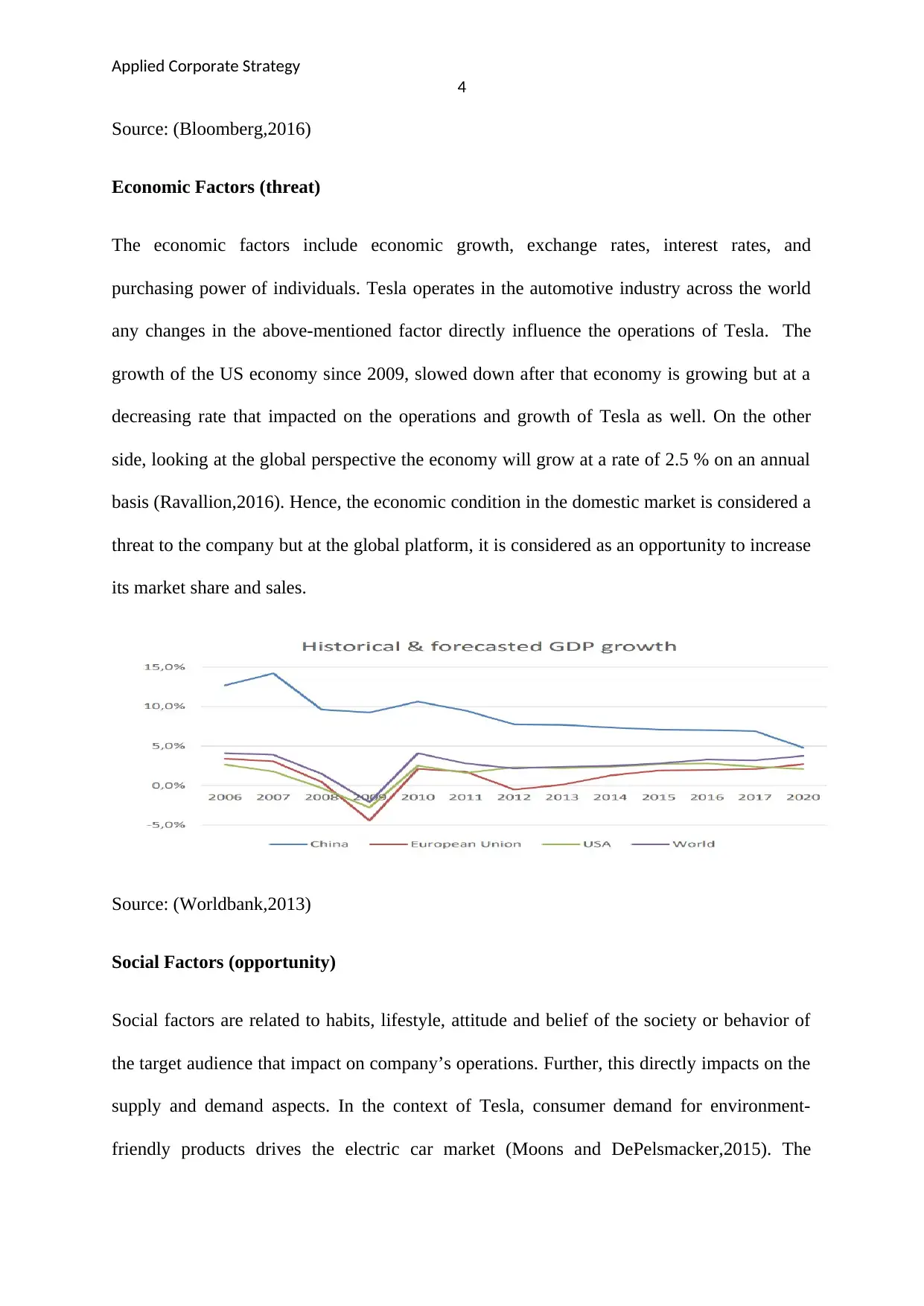
Applied Corporate Strategy
4
Source: (Bloomberg,2016)
Economic Factors (threat)
The economic factors include economic growth, exchange rates, interest rates, and
purchasing power of individuals. Tesla operates in the automotive industry across the world
any changes in the above-mentioned factor directly influence the operations of Tesla. The
growth of the US economy since 2009, slowed down after that economy is growing but at a
decreasing rate that impacted on the operations and growth of Tesla as well. On the other
side, looking at the global perspective the economy will grow at a rate of 2.5 % on an annual
basis (Ravallion,2016). Hence, the economic condition in the domestic market is considered a
threat to the company but at the global platform, it is considered as an opportunity to increase
its market share and sales.
Source: (Worldbank,2013)
Social Factors (opportunity)
Social factors are related to habits, lifestyle, attitude and belief of the society or behavior of
the target audience that impact on company’s operations. Further, this directly impacts on the
supply and demand aspects. In the context of Tesla, consumer demand for environment-
friendly products drives the electric car market (Moons and DePelsmacker,2015). The
4
Source: (Bloomberg,2016)
Economic Factors (threat)
The economic factors include economic growth, exchange rates, interest rates, and
purchasing power of individuals. Tesla operates in the automotive industry across the world
any changes in the above-mentioned factor directly influence the operations of Tesla. The
growth of the US economy since 2009, slowed down after that economy is growing but at a
decreasing rate that impacted on the operations and growth of Tesla as well. On the other
side, looking at the global perspective the economy will grow at a rate of 2.5 % on an annual
basis (Ravallion,2016). Hence, the economic condition in the domestic market is considered a
threat to the company but at the global platform, it is considered as an opportunity to increase
its market share and sales.
Source: (Worldbank,2013)
Social Factors (opportunity)
Social factors are related to habits, lifestyle, attitude and belief of the society or behavior of
the target audience that impact on company’s operations. Further, this directly impacts on the
supply and demand aspects. In the context of Tesla, consumer demand for environment-
friendly products drives the electric car market (Moons and DePelsmacker,2015). The
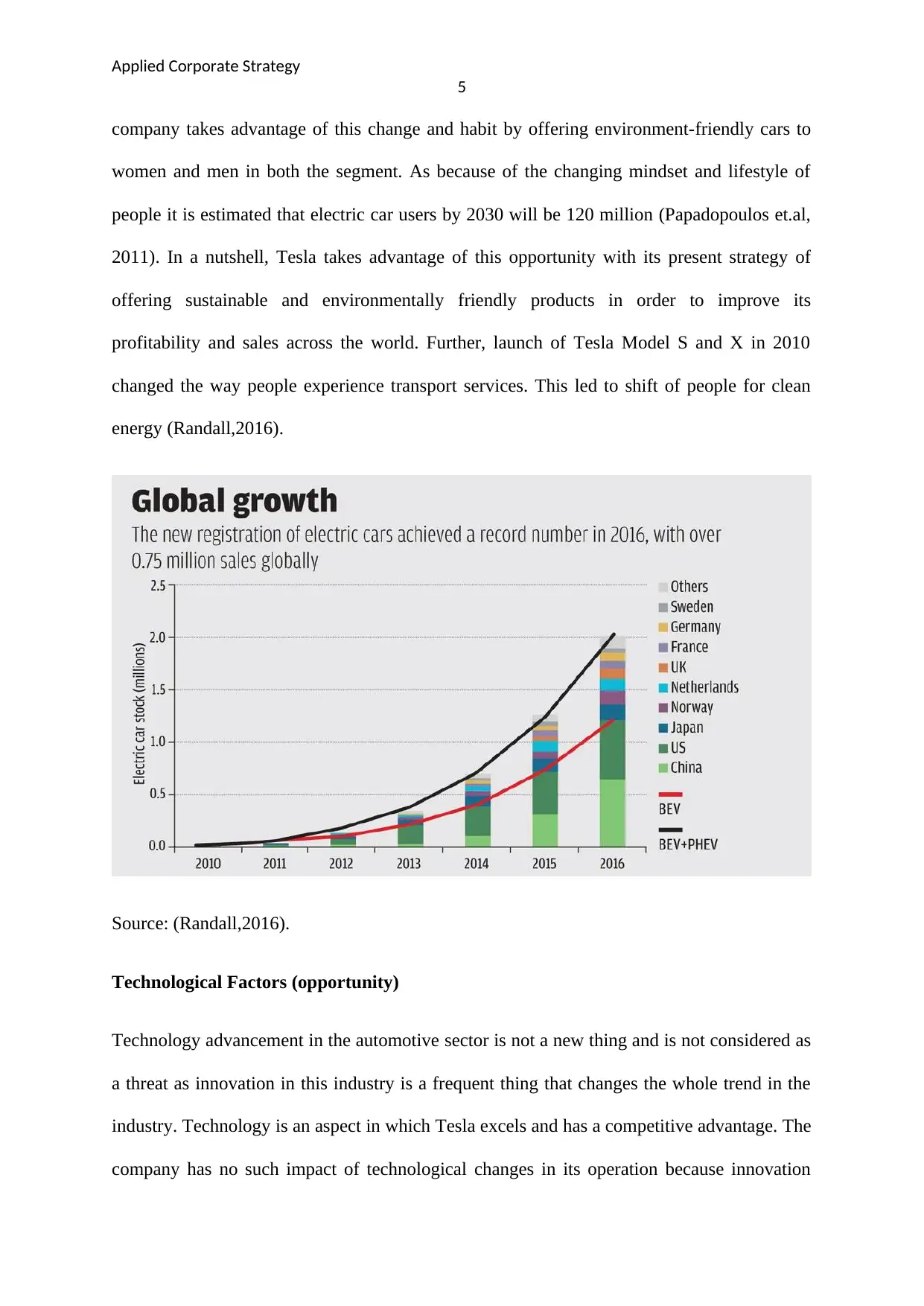
Applied Corporate Strategy
5
company takes advantage of this change and habit by offering environment-friendly cars to
women and men in both the segment. As because of the changing mindset and lifestyle of
people it is estimated that electric car users by 2030 will be 120 million (Papadopoulos et.al,
2011). In a nutshell, Tesla takes advantage of this opportunity with its present strategy of
offering sustainable and environmentally friendly products in order to improve its
profitability and sales across the world. Further, launch of Tesla Model S and X in 2010
changed the way people experience transport services. This led to shift of people for clean
energy (Randall,2016).
Source: (Randall,2016).
Technological Factors (opportunity)
Technology advancement in the automotive sector is not a new thing and is not considered as
a threat as innovation in this industry is a frequent thing that changes the whole trend in the
industry. Technology is an aspect in which Tesla excels and has a competitive advantage. The
company has no such impact of technological changes in its operation because innovation
5
company takes advantage of this change and habit by offering environment-friendly cars to
women and men in both the segment. As because of the changing mindset and lifestyle of
people it is estimated that electric car users by 2030 will be 120 million (Papadopoulos et.al,
2011). In a nutshell, Tesla takes advantage of this opportunity with its present strategy of
offering sustainable and environmentally friendly products in order to improve its
profitability and sales across the world. Further, launch of Tesla Model S and X in 2010
changed the way people experience transport services. This led to shift of people for clean
energy (Randall,2016).
Source: (Randall,2016).
Technological Factors (opportunity)
Technology advancement in the automotive sector is not a new thing and is not considered as
a threat as innovation in this industry is a frequent thing that changes the whole trend in the
industry. Technology is an aspect in which Tesla excels and has a competitive advantage. The
company has no such impact of technological changes in its operation because innovation
⊘ This is a preview!⊘
Do you want full access?
Subscribe today to unlock all pages.

Trusted by 1+ million students worldwide
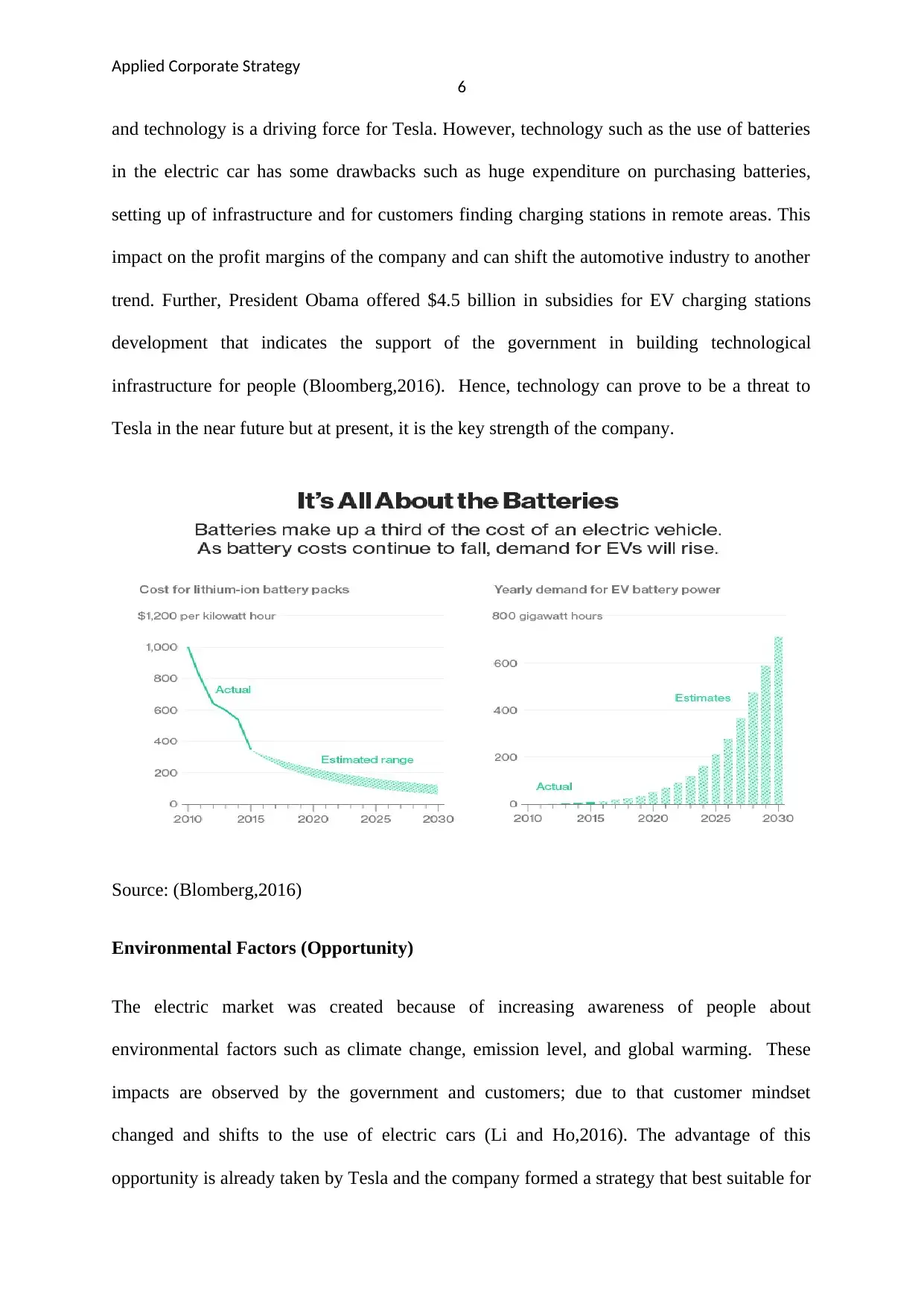
Applied Corporate Strategy
6
and technology is a driving force for Tesla. However, technology such as the use of batteries
in the electric car has some drawbacks such as huge expenditure on purchasing batteries,
setting up of infrastructure and for customers finding charging stations in remote areas. This
impact on the profit margins of the company and can shift the automotive industry to another
trend. Further, President Obama offered $4.5 billion in subsidies for EV charging stations
development that indicates the support of the government in building technological
infrastructure for people (Bloomberg,2016). Hence, technology can prove to be a threat to
Tesla in the near future but at present, it is the key strength of the company.
Source: (Blomberg,2016)
Environmental Factors (Opportunity)
The electric market was created because of increasing awareness of people about
environmental factors such as climate change, emission level, and global warming. These
impacts are observed by the government and customers; due to that customer mindset
changed and shifts to the use of electric cars (Li and Ho,2016). The advantage of this
opportunity is already taken by Tesla and the company formed a strategy that best suitable for
6
and technology is a driving force for Tesla. However, technology such as the use of batteries
in the electric car has some drawbacks such as huge expenditure on purchasing batteries,
setting up of infrastructure and for customers finding charging stations in remote areas. This
impact on the profit margins of the company and can shift the automotive industry to another
trend. Further, President Obama offered $4.5 billion in subsidies for EV charging stations
development that indicates the support of the government in building technological
infrastructure for people (Bloomberg,2016). Hence, technology can prove to be a threat to
Tesla in the near future but at present, it is the key strength of the company.
Source: (Blomberg,2016)
Environmental Factors (Opportunity)
The electric market was created because of increasing awareness of people about
environmental factors such as climate change, emission level, and global warming. These
impacts are observed by the government and customers; due to that customer mindset
changed and shifts to the use of electric cars (Li and Ho,2016). The advantage of this
opportunity is already taken by Tesla and the company formed a strategy that best suitable for
Paraphrase This Document
Need a fresh take? Get an instant paraphrase of this document with our AI Paraphraser
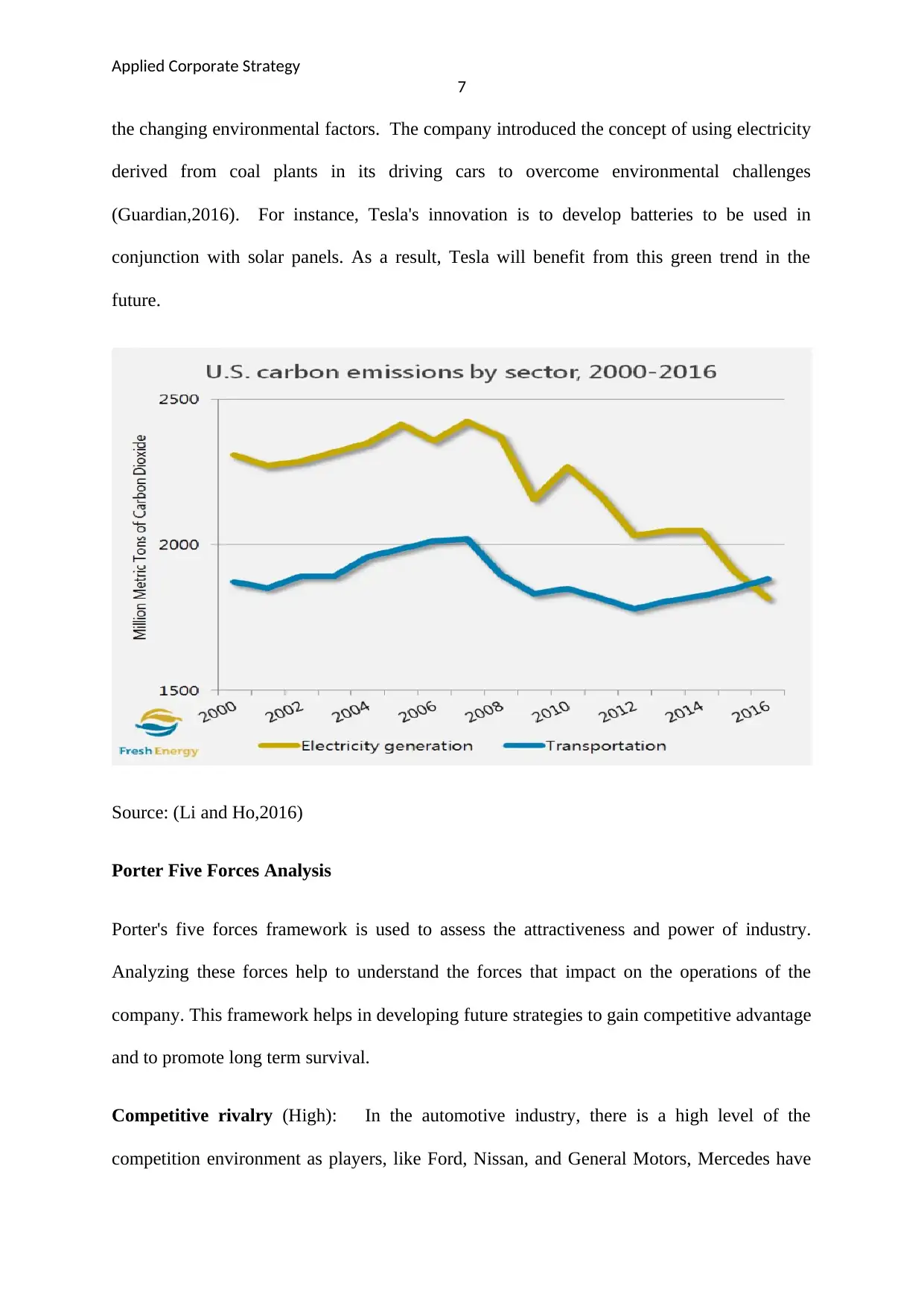
Applied Corporate Strategy
7
the changing environmental factors. The company introduced the concept of using electricity
derived from coal plants in its driving cars to overcome environmental challenges
(Guardian,2016). For instance, Tesla's innovation is to develop batteries to be used in
conjunction with solar panels. As a result, Tesla will benefit from this green trend in the
future.
Source: (Li and Ho,2016)
Porter Five Forces Analysis
Porter's five forces framework is used to assess the attractiveness and power of industry.
Analyzing these forces help to understand the forces that impact on the operations of the
company. This framework helps in developing future strategies to gain competitive advantage
and to promote long term survival.
Competitive rivalry (High): In the automotive industry, there is a high level of the
competition environment as players, like Ford, Nissan, and General Motors, Mercedes have
7
the changing environmental factors. The company introduced the concept of using electricity
derived from coal plants in its driving cars to overcome environmental challenges
(Guardian,2016). For instance, Tesla's innovation is to develop batteries to be used in
conjunction with solar panels. As a result, Tesla will benefit from this green trend in the
future.
Source: (Li and Ho,2016)
Porter Five Forces Analysis
Porter's five forces framework is used to assess the attractiveness and power of industry.
Analyzing these forces help to understand the forces that impact on the operations of the
company. This framework helps in developing future strategies to gain competitive advantage
and to promote long term survival.
Competitive rivalry (High): In the automotive industry, there is a high level of the
competition environment as players, like Ford, Nissan, and General Motors, Mercedes have
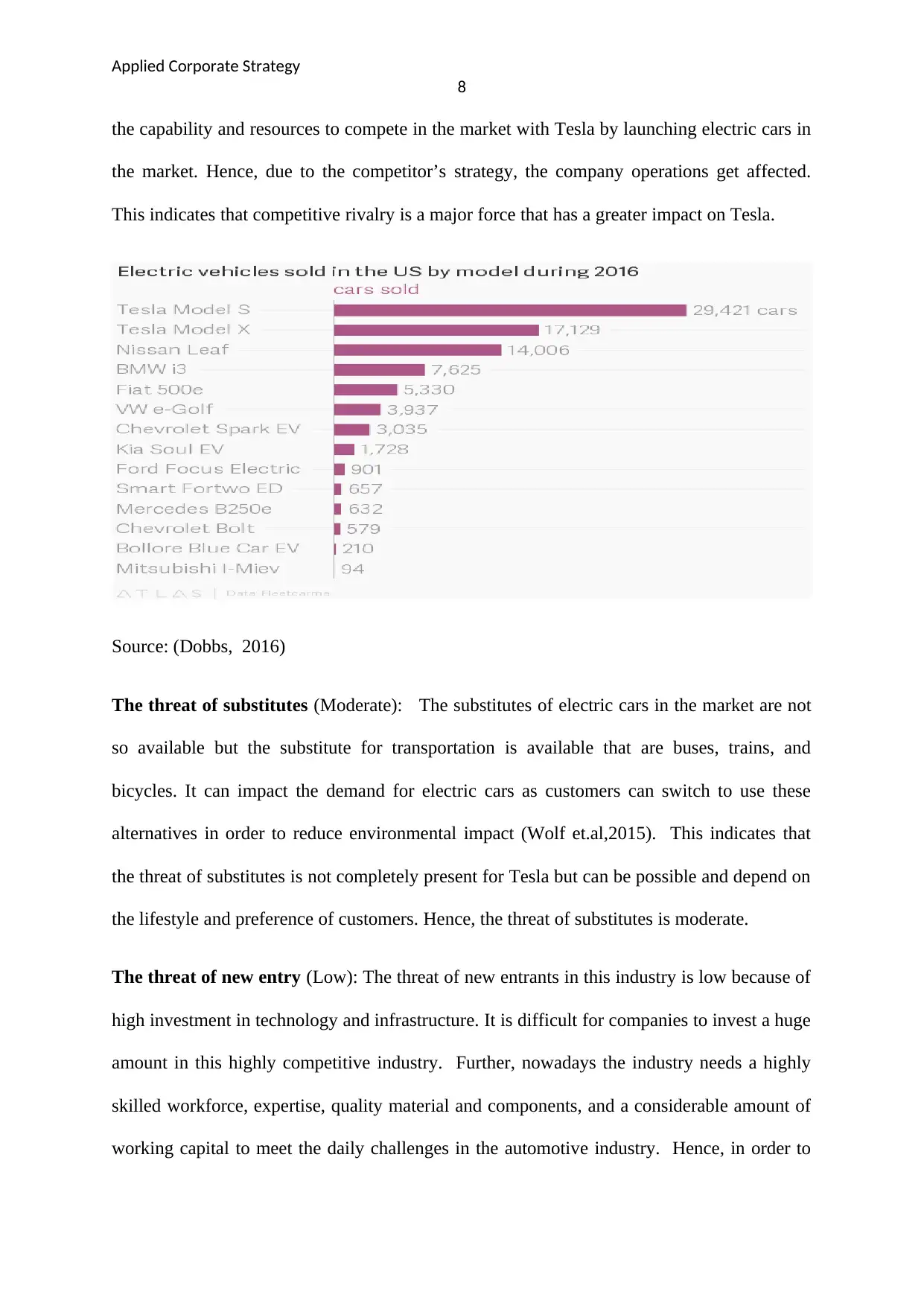
Applied Corporate Strategy
8
the capability and resources to compete in the market with Tesla by launching electric cars in
the market. Hence, due to the competitor’s strategy, the company operations get affected.
This indicates that competitive rivalry is a major force that has a greater impact on Tesla.
Source: (Dobbs, 2016)
The threat of substitutes (Moderate): The substitutes of electric cars in the market are not
so available but the substitute for transportation is available that are buses, trains, and
bicycles. It can impact the demand for electric cars as customers can switch to use these
alternatives in order to reduce environmental impact (Wolf et.al,2015). This indicates that
the threat of substitutes is not completely present for Tesla but can be possible and depend on
the lifestyle and preference of customers. Hence, the threat of substitutes is moderate.
The threat of new entry (Low): The threat of new entrants in this industry is low because of
high investment in technology and infrastructure. It is difficult for companies to invest a huge
amount in this highly competitive industry. Further, nowadays the industry needs a highly
skilled workforce, expertise, quality material and components, and a considerable amount of
working capital to meet the daily challenges in the automotive industry. Hence, in order to
8
the capability and resources to compete in the market with Tesla by launching electric cars in
the market. Hence, due to the competitor’s strategy, the company operations get affected.
This indicates that competitive rivalry is a major force that has a greater impact on Tesla.
Source: (Dobbs, 2016)
The threat of substitutes (Moderate): The substitutes of electric cars in the market are not
so available but the substitute for transportation is available that are buses, trains, and
bicycles. It can impact the demand for electric cars as customers can switch to use these
alternatives in order to reduce environmental impact (Wolf et.al,2015). This indicates that
the threat of substitutes is not completely present for Tesla but can be possible and depend on
the lifestyle and preference of customers. Hence, the threat of substitutes is moderate.
The threat of new entry (Low): The threat of new entrants in this industry is low because of
high investment in technology and infrastructure. It is difficult for companies to invest a huge
amount in this highly competitive industry. Further, nowadays the industry needs a highly
skilled workforce, expertise, quality material and components, and a considerable amount of
working capital to meet the daily challenges in the automotive industry. Hence, in order to
⊘ This is a preview!⊘
Do you want full access?
Subscribe today to unlock all pages.

Trusted by 1+ million students worldwide
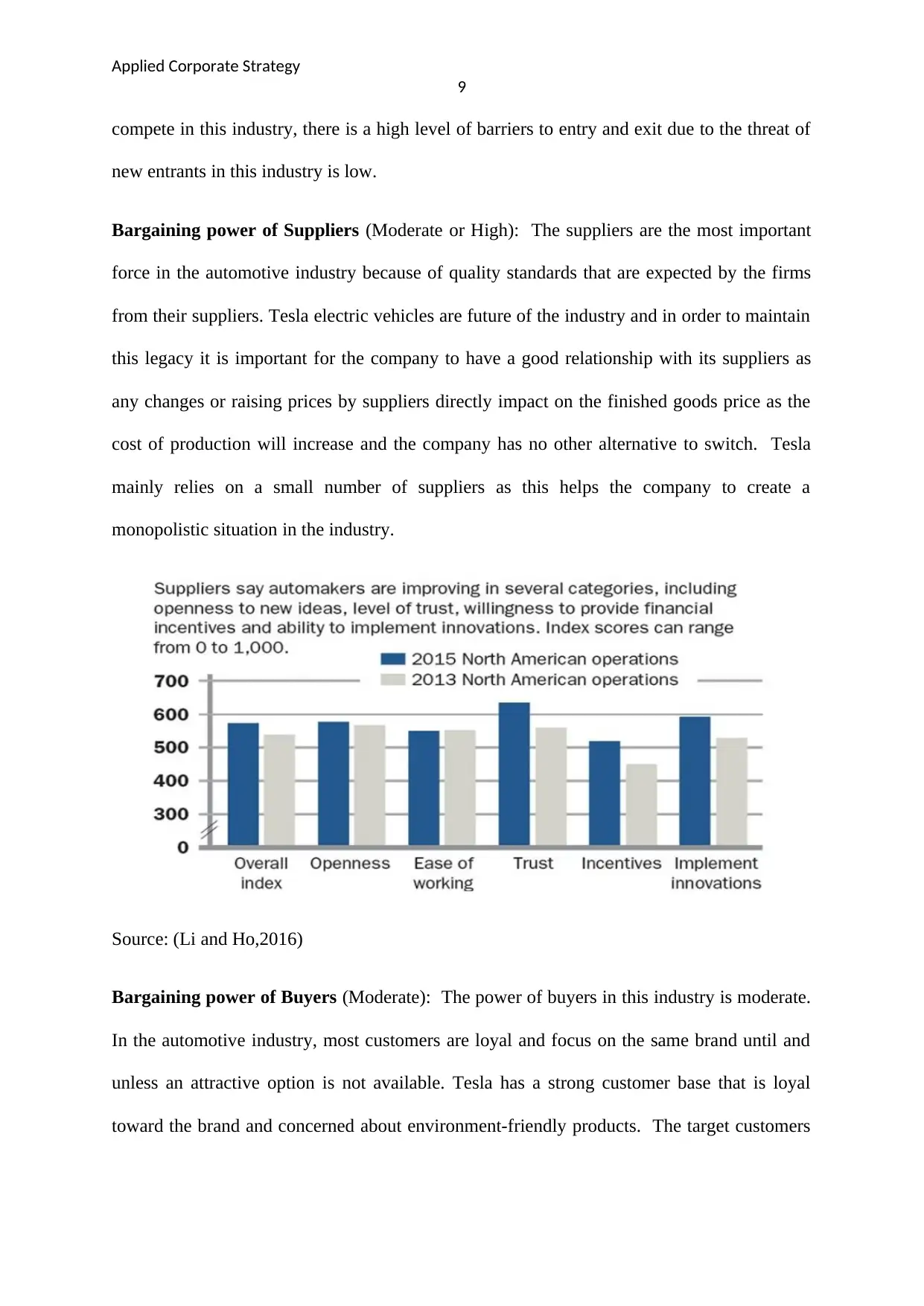
Applied Corporate Strategy
9
compete in this industry, there is a high level of barriers to entry and exit due to the threat of
new entrants in this industry is low.
Bargaining power of Suppliers (Moderate or High): The suppliers are the most important
force in the automotive industry because of quality standards that are expected by the firms
from their suppliers. Tesla electric vehicles are future of the industry and in order to maintain
this legacy it is important for the company to have a good relationship with its suppliers as
any changes or raising prices by suppliers directly impact on the finished goods price as the
cost of production will increase and the company has no other alternative to switch. Tesla
mainly relies on a small number of suppliers as this helps the company to create a
monopolistic situation in the industry.
Source: (Li and Ho,2016)
Bargaining power of Buyers (Moderate): The power of buyers in this industry is moderate.
In the automotive industry, most customers are loyal and focus on the same brand until and
unless an attractive option is not available. Tesla has a strong customer base that is loyal
toward the brand and concerned about environment-friendly products. The target customers
9
compete in this industry, there is a high level of barriers to entry and exit due to the threat of
new entrants in this industry is low.
Bargaining power of Suppliers (Moderate or High): The suppliers are the most important
force in the automotive industry because of quality standards that are expected by the firms
from their suppliers. Tesla electric vehicles are future of the industry and in order to maintain
this legacy it is important for the company to have a good relationship with its suppliers as
any changes or raising prices by suppliers directly impact on the finished goods price as the
cost of production will increase and the company has no other alternative to switch. Tesla
mainly relies on a small number of suppliers as this helps the company to create a
monopolistic situation in the industry.
Source: (Li and Ho,2016)
Bargaining power of Buyers (Moderate): The power of buyers in this industry is moderate.
In the automotive industry, most customers are loyal and focus on the same brand until and
unless an attractive option is not available. Tesla has a strong customer base that is loyal
toward the brand and concerned about environment-friendly products. The target customers
Paraphrase This Document
Need a fresh take? Get an instant paraphrase of this document with our AI Paraphraser
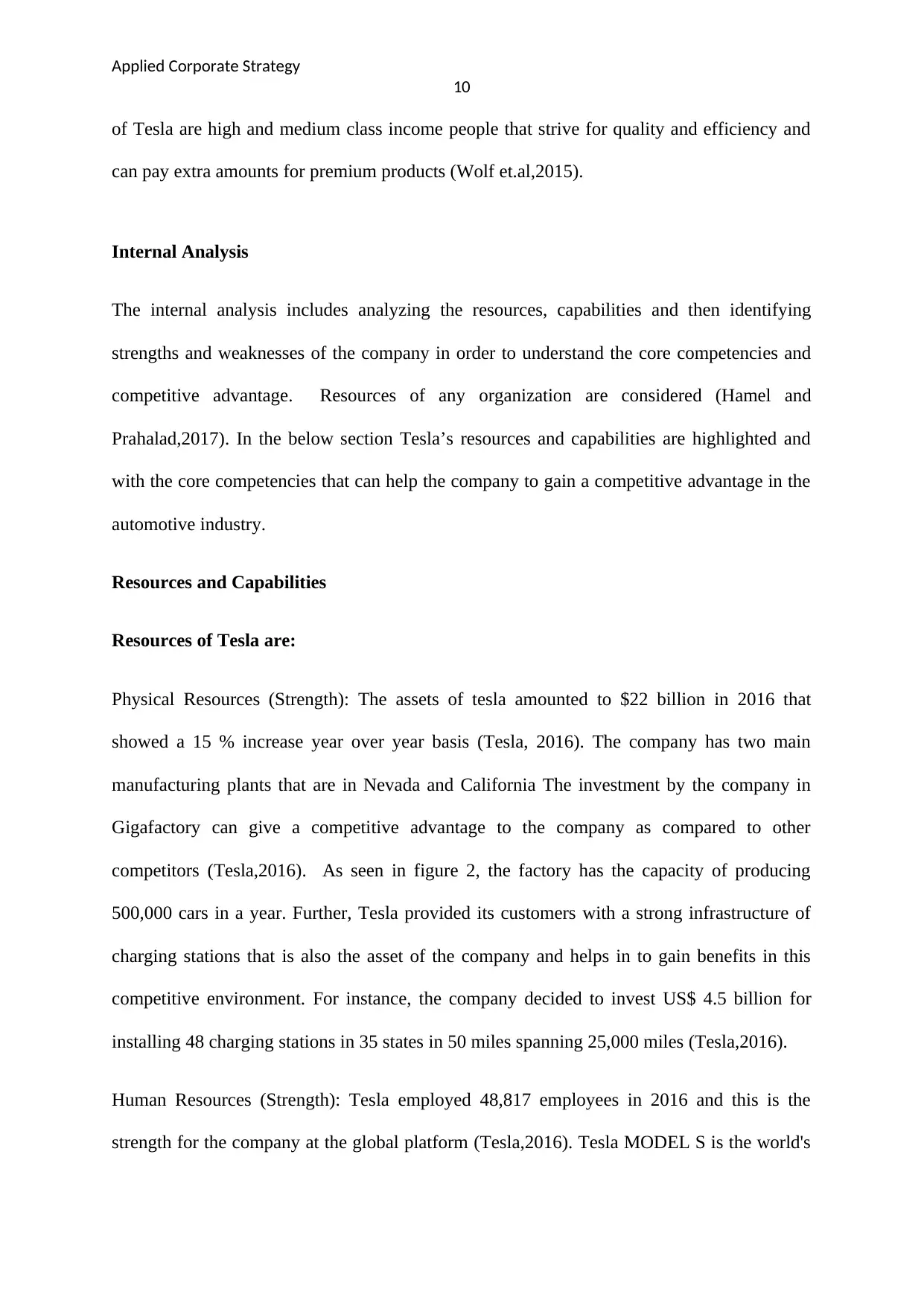
Applied Corporate Strategy
10
of Tesla are high and medium class income people that strive for quality and efficiency and
can pay extra amounts for premium products (Wolf et.al,2015).
Internal Analysis
The internal analysis includes analyzing the resources, capabilities and then identifying
strengths and weaknesses of the company in order to understand the core competencies and
competitive advantage. Resources of any organization are considered (Hamel and
Prahalad,2017). In the below section Tesla’s resources and capabilities are highlighted and
with the core competencies that can help the company to gain a competitive advantage in the
automotive industry.
Resources and Capabilities
Resources of Tesla are:
Physical Resources (Strength): The assets of tesla amounted to $22 billion in 2016 that
showed a 15 % increase year over year basis (Tesla, 2016). The company has two main
manufacturing plants that are in Nevada and California The investment by the company in
Gigafactory can give a competitive advantage to the company as compared to other
competitors (Tesla,2016). As seen in figure 2, the factory has the capacity of producing
500,000 cars in a year. Further, Tesla provided its customers with a strong infrastructure of
charging stations that is also the asset of the company and helps in to gain benefits in this
competitive environment. For instance, the company decided to invest US$ 4.5 billion for
installing 48 charging stations in 35 states in 50 miles spanning 25,000 miles (Tesla,2016).
Human Resources (Strength): Tesla employed 48,817 employees in 2016 and this is the
strength for the company at the global platform (Tesla,2016). Tesla MODEL S is the world's
10
of Tesla are high and medium class income people that strive for quality and efficiency and
can pay extra amounts for premium products (Wolf et.al,2015).
Internal Analysis
The internal analysis includes analyzing the resources, capabilities and then identifying
strengths and weaknesses of the company in order to understand the core competencies and
competitive advantage. Resources of any organization are considered (Hamel and
Prahalad,2017). In the below section Tesla’s resources and capabilities are highlighted and
with the core competencies that can help the company to gain a competitive advantage in the
automotive industry.
Resources and Capabilities
Resources of Tesla are:
Physical Resources (Strength): The assets of tesla amounted to $22 billion in 2016 that
showed a 15 % increase year over year basis (Tesla, 2016). The company has two main
manufacturing plants that are in Nevada and California The investment by the company in
Gigafactory can give a competitive advantage to the company as compared to other
competitors (Tesla,2016). As seen in figure 2, the factory has the capacity of producing
500,000 cars in a year. Further, Tesla provided its customers with a strong infrastructure of
charging stations that is also the asset of the company and helps in to gain benefits in this
competitive environment. For instance, the company decided to invest US$ 4.5 billion for
installing 48 charging stations in 35 states in 50 miles spanning 25,000 miles (Tesla,2016).
Human Resources (Strength): Tesla employed 48,817 employees in 2016 and this is the
strength for the company at the global platform (Tesla,2016). Tesla MODEL S is the world's
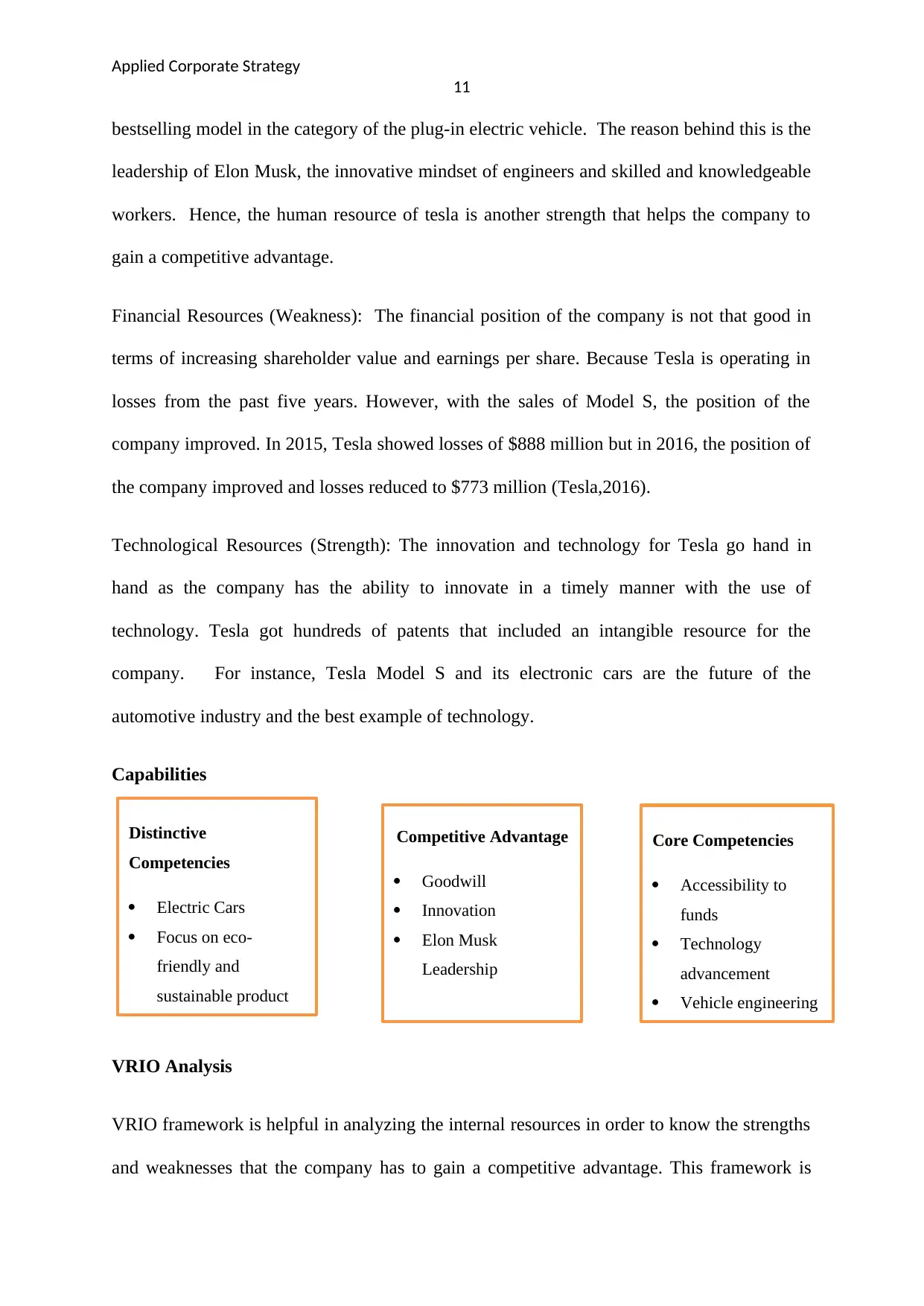
Applied Corporate Strategy
11
bestselling model in the category of the plug-in electric vehicle. The reason behind this is the
leadership of Elon Musk, the innovative mindset of engineers and skilled and knowledgeable
workers. Hence, the human resource of tesla is another strength that helps the company to
gain a competitive advantage.
Financial Resources (Weakness): The financial position of the company is not that good in
terms of increasing shareholder value and earnings per share. Because Tesla is operating in
losses from the past five years. However, with the sales of Model S, the position of the
company improved. In 2015, Tesla showed losses of $888 million but in 2016, the position of
the company improved and losses reduced to $773 million (Tesla,2016).
Technological Resources (Strength): The innovation and technology for Tesla go hand in
hand as the company has the ability to innovate in a timely manner with the use of
technology. Tesla got hundreds of patents that included an intangible resource for the
company. For instance, Tesla Model S and its electronic cars are the future of the
automotive industry and the best example of technology.
Capabilities
VRIO Analysis
VRIO framework is helpful in analyzing the internal resources in order to know the strengths
and weaknesses that the company has to gain a competitive advantage. This framework is
Competitive Advantage
Goodwill
Innovation
Elon Musk
Leadership
Distinctive
Competencies
Electric Cars
Focus on eco-
friendly and
sustainable product
Core Competencies
Accessibility to
funds
Technology
advancement
Vehicle engineering
11
bestselling model in the category of the plug-in electric vehicle. The reason behind this is the
leadership of Elon Musk, the innovative mindset of engineers and skilled and knowledgeable
workers. Hence, the human resource of tesla is another strength that helps the company to
gain a competitive advantage.
Financial Resources (Weakness): The financial position of the company is not that good in
terms of increasing shareholder value and earnings per share. Because Tesla is operating in
losses from the past five years. However, with the sales of Model S, the position of the
company improved. In 2015, Tesla showed losses of $888 million but in 2016, the position of
the company improved and losses reduced to $773 million (Tesla,2016).
Technological Resources (Strength): The innovation and technology for Tesla go hand in
hand as the company has the ability to innovate in a timely manner with the use of
technology. Tesla got hundreds of patents that included an intangible resource for the
company. For instance, Tesla Model S and its electronic cars are the future of the
automotive industry and the best example of technology.
Capabilities
VRIO Analysis
VRIO framework is helpful in analyzing the internal resources in order to know the strengths
and weaknesses that the company has to gain a competitive advantage. This framework is
Competitive Advantage
Goodwill
Innovation
Elon Musk
Leadership
Distinctive
Competencies
Electric Cars
Focus on eco-
friendly and
sustainable product
Core Competencies
Accessibility to
funds
Technology
advancement
Vehicle engineering
⊘ This is a preview!⊘
Do you want full access?
Subscribe today to unlock all pages.

Trusted by 1+ million students worldwide
1 out of 22
Related Documents
Your All-in-One AI-Powered Toolkit for Academic Success.
+13062052269
info@desklib.com
Available 24*7 on WhatsApp / Email
![[object Object]](/_next/static/media/star-bottom.7253800d.svg)
Unlock your academic potential
Copyright © 2020–2025 A2Z Services. All Rights Reserved. Developed and managed by ZUCOL.





